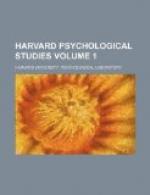Feminine Rhymes. Hu. 18 21a 37a 19b 19 20a 22a 16b 19 21a 21a 16b Mc. 36 72a 64 51a 36 x32 41a 40 22 22a x18 29a Ha. 27 31a 44b 28a 36 79 x30 40 30 36 79a 30b 31 38 50a 36 32 39a 42 40a Am. 34 70 95a 85 35 73a 94 89a 30 45 47a 86 28 54 53a 70 G. 19 64a 64 79a 19 73a 83b 76a 21 81 67a — 19 61 83a 79
The rhymes are marked ‘a’
and ‘b’; e.g., couplets a, a, b,
b,
etc. Verse pauses in italics are equal
to the foot pause; those
marked ‘x’ are less than the
foot pause.
3. Modification of the Normal Form of Verse due to Rhyme.
Verse Pause in Rhymed Material.
There are as wide, isolated variations as in the case of unrhymed material. As compared with unrhymed verse, the pause is in general decidedly shorter. The verse pauses of the feminine rhymes are generally much like those of the end rhymed material. But there are very few cases of the verse pause being as short as the foot pause—only four cases in sixty (6.6 per cent.). See Table IX.
This wide variation of the verse pause and its occasional equivalence to the foot pause in rhymed verses is in accord with the notion that the rhyme in some way brings the verse to a close by a process more rapid than that in unrhymed material.
The introduction of rhyme seems to be favorable to the division of a stanza into two parts by producing an unusually long verse pause after the second verse. Of 43 unrhymed stanzas there are 19 which show a decidedly long pause at the close of some one of the verses. But of these 19 cases, only 8 (18 per cent.) have the break at the close of the second verse. Of 64 rhymed stanzas, 29 show the division, and of this 29, 22 (34 per cent.) have the break at the close of the second verse.
Influence of the Rhymes on Intensities.
The intensities at the close of the verse, without rhyme, may be slightly greater than within the verse. The dynamic shading of the verse is elastic, and a variety of forms is possible, a decrescendo at the close of the verse is not unusual (cf. Table VIII.). But when the rhyme is introduced the general dynamic form of the verse is fixed, and in the material measured this is true not only of the verses in a stanza which contain the rhyme but of other verses in the same stanza.




